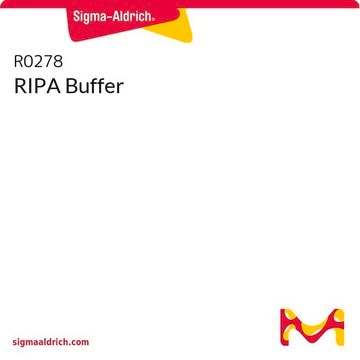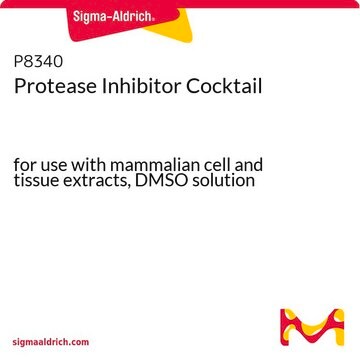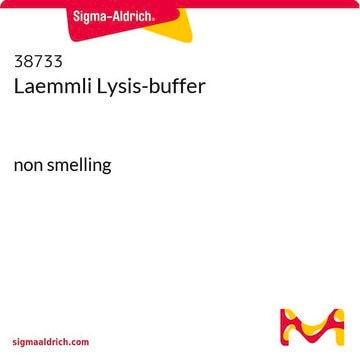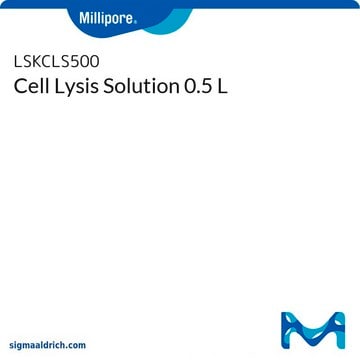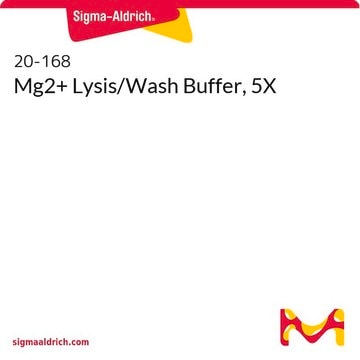Freeze-thaw cycles may lead to degradation of added phosphatase and protease inhibitors. It is highly recommended to prepare the cocktail just prior to application.
20-188
Tampone di lisi RIPA, 10X
100 mL RIPA Lysis Buffer, 10X for Immunoprecipitation & Western Blotting.
Sinonimo/i:
lysis buffer
About This Item
Prodotti consigliati
Stato
liquid
Confezionamento
pkg of 100 mL
Produttore/marchio commerciale
Upstate®
tecniche
immunoprecipitation (IP): suitable
western blot: suitable
Condizioni di spedizione
ambient
Descrizione generale
Applicazioni
Stato fisico
Stoccaggio e stabilità
Note legali
Esclusione di responsabilità
Avvertenze
Danger
Indicazioni di pericolo
Consigli di prudenza
Classi di pericolo
Aquatic Chronic 3 - Eye Dam. 1
Codice della classe di stoccaggio
10 - Combustible liquids
Classe di pericolosità dell'acqua (WGK)
WGK 3
Certificati d'analisi (COA)
Cerca il Certificati d'analisi (COA) digitando il numero di lotto/batch corrispondente. I numeri di lotto o di batch sono stampati sull'etichetta dei prodotti dopo la parola ‘Lotto’ o ‘Batch’.
Possiedi già questo prodotto?
I documenti relativi ai prodotti acquistati recentemente sono disponibili nell’Archivio dei documenti.
I clienti hanno visto anche
-
Can I prepare 10 ml of 1x RIPA buffer and add phosphatase and protease inhibitor then aliquot it to 1 ml Eppendorf tubes and store at -20 for use?
1 answer-
Helpful?
-
-
Can this lysis extract protein from the Nucleus?
1 answer-
RIPA Buffer enables the extraction of cytoplasmic, membrane, and nuclear proteins. Certain proteins are more soluble in RIPA buffer than others.
Helpful?
-
-
How long can 1x RIPA lysis buffer be stored with or without the protease?
1 answer-
This product is stable at room temperature for 6 months from date of shipment. Protease and phosphatase inhibitors should be added immediately prior to use.
Helpful?
-
-
I used the 10X RIPA buffer to lyse my cultured cells. How can I do next? Will it affect the protein quantification by using BCA assay kit? Also, will it affect the SDS-PAGE and Western blot?
1 answer-
Protein samples prepared from cell culture lysates using this 1X RIPA buffer are typically compatible with downstream applications such as BCA assay, SDS-PAGE, and Western blotting. The concentrations of salts and detergents present in the 1X RIPA buffer are relatively low, minimizing interference with these techniques.
Helpful?
-
-
Can we store it a 4 degree, if we want to use it after 6 months?
1 answer-
Studies have not been performed to determine if refrigerated storage will extend the shelf life of this product. The end user would have to determine suitability if used after the recommended 6 months. Note that product R0278, a 1X Ripa Buffer, is stored refrigerated and includes a warranty of 1 year from the date of shipment. Please see the link below to review this product datasheet:
https://www.sigmaaldrich.com/deepweb/assets/sigmaaldrich/product/documents/350/775/r0278bul.pdfHelpful?
-
-
Someone in lab left the 10X RIPA Buffer in room temperature for overnight. Will it affect the quality of the buffer? Could we continue to use it?
1 answer-
This product does not require refrigeration and is stable at room temperature for up to 6 months.
Helpful?
-
-
Do I used distilled water to dilute to 1X?
1 answer-
The 10X RIPA Lysis Buffer should be diluted with nine parts sterile, distilled water.
Helpful?
-
-
Do I have to dilute to 1X for protein isolation?
1 answer-
Yes, RIPA lysis buffer should be diluted to 1X prior to use.
Helpful?
-
Active Filters
Il team dei nostri ricercatori vanta grande esperienza in tutte le aree della ricerca quali Life Science, scienza dei materiali, sintesi chimica, cromatografia, discipline analitiche, ecc..
Contatta l'Assistenza Tecnica.